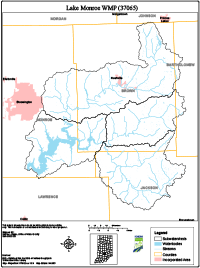Lake Monroe is the largest lake in Indiana, providing drinking water for over 130,000 people and generating over $40 million annually in recreational spending. In 2018, Friends of Lake Monroe brought together local public officials and concerned citizens to apply for a 319 grant from IDEM to develop a watershed management plan (WMP). The Lake Monroe WMP development was guided by a steering committee with members representing farmers, businesses, city government, town government, county government, natural resource professionals, educational entities, land managers, and environmental groups. The WMP identifies the top threats to water quality in Lake Monroe and provides an action plan to address those threats over the next 20 years. Protecting water quality in Lake Monroe will require reducing phosphorus, nitrogen, sediment, and E. coli loads entering the lake from the watershed.
Lake Monroe’s watershed is large (441 square miles) and spans portions of Brown, Jackson, and Monroe Counties. Topography is steep and soil is highly erodible. Over 82% of the watershed is forested and farming is generally limited to the wide valleys of Lake Monroe’s three main tributaries (North Fork, Middle Fork, and South Fork Salt Creek). The area is largely rural and an estimated 9,000 households are served by on-site septic systems. Pollutants in the watershed such as fertilizer, animal manure, sediment, and septic system leakage are washed into the lake when it rains.
The key to protecting and improving water quality in the lake is to keep pollutants such as sediment, fertilizer, animal manure, and septic system leakage from reaching the streams that flow into Lake Monroe. A key strategy will be increasing the use of best management practices (BMPs) on agricultural, forested, residential, and urban land in the watershed. Improving water quality by modifying the watershed is a long-term process. The 2022 Lake Monroe WMP outlines a twenty-year timeline of activities. Key strategies include:
- Increasing the adoption of BMPs on agricultural and forested land
- Expanding riparian buffer along streams
- Maintaining and repairing septic systems
- Encouraging green boating practices and “leave no trace” principles
- Stabilizing key sections of shoreline and streambanks
- Protecting and restoring floodplains, especially along the three main tributaries (South Fork, Middle Fork, and North Fork Salt Creek)
- Reducing the amount of littering in the watershed
- Promoting collaboration between different governmental bodies in the watershed
- Monitoring water quality to evaluate impacts
The Lake Monroe WMP meets the requirements of IDEM’s 2009 Watershed Management Plan Checklist and was approved by IDEM and EPA in February 2022.
The Complete Lake Monroe Watershed Management Plan

